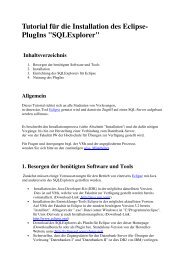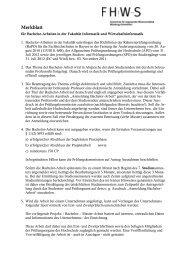FHWS Science Journal - Fakultät Informatik und Wirtschaftsinformatik
FHWS Science Journal - Fakultät Informatik und Wirtschaftsinformatik
FHWS Science Journal - Fakultät Informatik und Wirtschaftsinformatik
Create successful ePaper yourself
Turn your PDF publications into a flip-book with our unique Google optimized e-Paper software.
Christian Mager<br />
maintaining the processes [Van Bon 2008]. CSI recommends a permanent performance<br />
measurement and analysis of service delivery processes. Due to this, the measurement of SLA<br />
and the comparison to defined requirements are extremely important. To discover violations and<br />
measure the quality of service, SLA monitoring techniques can be used. Multiple technical<br />
approaches have been developed in the past to enable SLA monitoring [Ameller and Franch<br />
2008]; [Molina-Jimenez et al. 2004]; [Keller and Ludwig 2003]. However, all of these approaches<br />
focus on monitoring only and are not suitable for detecting issues in the processes. In [Grigori et<br />
al. 2004] an approach is introduced which considers the idea to measure and control business<br />
processes in an integrated framework. This idea comes close to the one addressed in this paper,<br />
yet it doesn't allow the dynamical adjustment of process models. State-of-the art Process Mining<br />
techniques are able to adjust a model considering additional event logs.<br />
3 PROCESS MINING FOR ANALYZING SERVICE LEVEL AGREEMENTS<br />
One of the most important quality attributes processes determined by SLAs is the time<br />
perspective. For this reason, proper management and monitoring of time-related process<br />
performance is of upmost importance. Van der Aalst introduced an approach called: "Mining<br />
additional Perspectives" in [Van der Aalst 2011]. This approach can be used to extend a process<br />
model generated by a Process Model Discovery algorithm with additional perspectives. His idea is<br />
generic and can be adopted with changes to the problem addressed in this paper.<br />
To create an integrated process model that contains not only the control-flow perspective but<br />
also the time perspective, the following information has to be available. Each process instance in<br />
the log needs to be identifiable on the basis of a unique case identifier. Additionally, all events that<br />
took place within one instance have to be ordered due to their occurrence. These two pieces of<br />
information are enough for the α-Algorithm for model discovery to extract the control-flow of a<br />
process. The control-flow of a process illustrates the actual process model as it is documented in<br />
the process log. Yet, for enriching the model with the time perspective, a timestamp of start and<br />
end time of each activity needs to be recorded in the log. These timestamps are used to calculate<br />
the waiting time and the service time of all activities in the model. In this context, waiting time<br />
corresponds to the time that passes by between the complete event of an activity and the start<br />
event of the following activity. During the waiting time, the process is simply waiting for the next<br />
execution step and no progress is made. Waiting time is particularly destructive from the point of<br />
view of the service provider as time passes by although the contractually agreed processing time<br />
is running. The so called service time refers to the time between the start event and the complete<br />
event of an activity. Having an event log with at least this data, the way of creating the integrated<br />
process model is explained shortly in the following three steps:<br />
(1) Derive event log suitable for Process Model Discovery. In other words, gather and merge<br />
event log data and transform it into a format, e.g. the XES-format, which is suitable for Process<br />
Mining.<br />
(2) Use the α-Algorithm for model discovery to compute an appropriate process model.<br />
Thereby, the algorithm scans the event log for causal dependencies of activities and puts them<br />
together to a Petri net process model. The Petri net model describes the control-flow perspective<br />
of the process.<br />
(3) Extend the Petri net model by an additional perspective including time information. The<br />
dotted chart analysis, for instance, suits well for comparing and analyzing processing time. The<br />
dotted chart analysis shows the occurrence of events over time. This time information for each<br />
activity is based on its' start and complete event in the event log. By using start and end time of<br />
each activity, the waiting and the service time can be derived. Afterwards, this time information is<br />
displayed in the integrated model and compared to the target time.<br />
52 <strong>FHWS</strong> <strong>Science</strong> <strong>Journal</strong>, Vol. 1, No. 1, 2013








